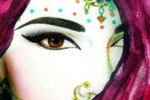In her new book, entitled Visibly Muslim: Fashion, Politics, Faith, Emma Tarlo captures the diversity in the way that Islam is practiced against the backdrop of multi-cultural Britain. Refreshingly, the book did not aim to answer whether or not covering was a part of Islam, and neither did it represent the views of Muslim women as a monolithic body.

Tarlo's book. Image via Amazon.com
In her book, Tarlo shows a snapshot of the way in which the veil has manifested itself within the Muslim population of Britain. In focusing on the way that different Muslim women struggle to find common ground between various identities, and the reactions of those around them, Tarlo looks at the veil as a part of the changing dynamics of members of a newer community, rather than an exposé that aims to penetrate the “secret world of Muslim women.”
Within the book, Tarlo moves from discussing high-profile Muslim women, to fashion, the hijab as a part of politics, and the fluid relationship between culture and religion. She does not gloss over the difficulties in finding a bridge between identities. When I saw the words “fashion” and “veil” together, I was worried that I would be confronted with a piece that would merely wax poetic about the intricate embroidery of hijab and the wonderful colors and trends that are starting to rival the Western fashion industry. Instead, Tarlo does depict changing fashions for Muslim women, but rather as a part of personal journeys. Furthermore, she analyzes the discourse surrounding the emerging market for “modest fashion.”
The most hard-hitting theme of the book was that of integration. In writing about some of the challenges faced by Muslim women within British communities, I could definitely relate. While Tarlo introduced a great deal of personal narratives from a wide range of women, she also brought into play some of the debate surrounding the hijab within the Muslim community itself. Finding a sense of identity and purpose is a concept which most people–not just Muslims–can relate to. What was refreshing was that she did not glorify or vilify groups that were more “modern” than others, but simply left the reader to try to understand the realities of grasping for a sense of identity. In showing this theme of integration as a part of juggling different identities, rather than a poisonous and foreign part of society, it forced me to really reflect on how difficult it is for anyone to try to fit in on any level. Rather than trying to promote an “acceptable” level of integration, Tarlo merely provides a picture of the realities of the Muslim community in Britain. This is significant because she does not depict it as a threat, but rather as important debate that shows that the face of Islam is changing and growing, as with many immigrant communities.
What I felt was monumentally missing from Tarlo’s work was the voice of Muslim women who have either been forced to veil or took it off. While she did a great job in showing the diversity of religious views and coming to the veil, I think that in analyzing the world of hijab, it is important to understand why women may reject it entirely. Also, I felt that she could have analyzed the role of socioeconomic status a bit more within the book. While the role of fashion is very significant in trying to understand the identities of Muslim women, I felt that fashion may have a different place and even the hijab itself may play a different role for someone that may not be able to afford the diversity in dress.
Despite being left with these questions, overall, I was impressed with the book’s fluid style, beautiful pictures, and honest stories. Furthermore, I enjoyed Tarlo’s dedication to trying to capture not only a snapshot of the Muslim community within Britain, but also in trying to introduce the difficulties within the Islamic community itself. She does not glorify the hijab or Islam, but rather highlights the realities faced by Muslim women.



